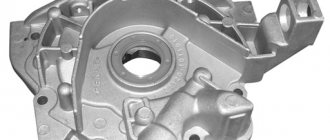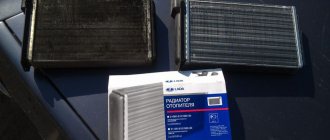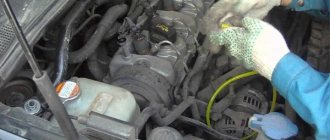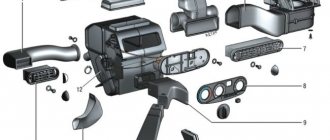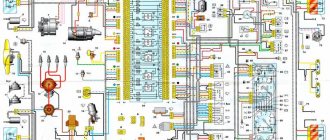Unlike other brands in the budget segment, the Chevrolet Lanos is equipped with an autonomous heating system. Heating of the windshield and interior with a flow of warm air together with the air conditioning system. This design has advantages and disadvantages. Let's take a step-by-step look at why the stove on a Chevrolet Lanos does not heat well.
Features of the heating system
Chevrolet Lanos - thanks to its successful unpretentious layout and relatively low cost, quickly gained popularity among Russian motorists.
According to statistics, this car entered the top 25 (24th place) best-selling in Russia. However, the car has one significant drawback. The stove does not heat as much as we would like in the harsh Russian winter. The reason is that it is designed for milder climates. Changing the situation is also problematic. The fact is that the radiator with dimensions 220x228 has a thickness of only 28 mm. For comparison, here is an analogue of the Zhiguli. With overall dimensions of 225 × 285, it has a thickness of 85 mm.
The first thought that comes to mind is to change the radiator to a “thicker” one. But it’s incredibly difficult to establish anything else. A larger device is simply not suitable. To “push” it, you need to remove the ventilation box, and this will depressurize the air conditioner. You will have to tinker and redo the internal structure of the oven boxes. All heating will need to be changed. To do this kind of work, you need to spend a lot of time and effort and be a very experienced mechanic.
It is much easier to come to terms with a small defect in your favorite car and maintain its heating system in good condition. Repairs will now cost a pretty penny. Replacing the Lanos heater damper alone costs about 900 rubles. To avoid unnecessary expenses, take care of your favorite car. And you need to start with the correct adjustment of the shock absorbers.
Suspension tuning
The Chevrolet Lanos suspension has decent characteristics designed for the average driver. Many owners want to customize the car to suit themselves and their driving style. Therefore, they resort to suspension tuning.
Table - Chevrolet Lanos suspension tuning
| Suspension tuning option | The main advantages of modernization | Negative sides of suspension tuning |
| Increased clearance | Improving the cross-country ability and carrying capacity of the vehicle | Increased risk of losing control of the car |
| Reducing ground clearance | Creating a sporty car look | The emergence of difficulties in overcoming obstacles on the road surface |
| Increased rigidity | Increased load capacity and reduced rollability | Reduced ride comfort |
| Adding softness | Comfort when driving on roads with potholes and potholes | Vehicle sagging when loading cargo and roll when cornering |
| Air suspension | The ability to adjust the suspension to your driving style and road conditions | High cost and lack of reliability |
Removing the heater core
After unscrewing all the screws, you can remove the structure. The front part slides down and the back part is pressed to the floor. This way the cap can be pulled out from under the radiator. On a Chevrolet Lanos car, the heater radiator is held in place using a latch and bracket near the pipes. This can only be seen in the mirror. After unscrewing the screw, remove the clamp and fold the bracket. Now the radiator can be removed and replaced with a new one. It should be noted that the latch is attached to a plastic rod, which will break easily. Therefore, we must act carefully.
The thermostat has failed
The second reason why the stove does not heat well on a Chevrolet Lanos is a broken thermostat. This device is quite fragile and easily breaks down. How to recognize that the thermostat is broken? When the engine is warm, the antifreeze temperature needle will rise very slowly and not reach the desired value. Also touch the pipes connecting the radiator and thermostat. They will either heat up very quickly (although the stove, according to the sensors, has not yet warmed up), or will remain cold. There is only one solution - replacing the thermostat.
Diagnostics and troubleshooting
Since all elements of the heating system are interconnected, finding out the cause of the malfunction can sometimes be quite difficult. Such symptoms can occur for various reasons. In the cold season, the main symptom of a faulty stove is poor heating - cold or slightly warm air enters the cabin. This may happen for the following reasons.
| Engine cooling thermostat malfunction | Formation of an air plug inside the radiator, preventing the movement of coolant | Clogged heater radiator channels |
| As a result, the antifreeze does not heat up to operating temperature. This can be checked without removing the thermostat. It is necessary to touch the pipe from the thermostat outlet to the cooling radiator with your hand. If, after starting a cold engine, it immediately begins to warm up, the thermostat does not block the flow of coolant, allowing it to flow in a large circle through the radiator of the cooling system. With a working thermostat, the temperature of the tube should gradually increase to 70–80 ° C. | The heater radiator stops heating, and the forced cooling fan of the main radiator often turns on. Getting rid of the gateway is quite simple. It is necessary to stop the car on a steep slope or drive along an overpass at an angle of 30–35 ° C. Then you should open the expansion tank and, while idling, sharply press the accelerator pedal several times. If this doesn't work, the radiator is likely clogged with dirt and sediment. | Coolant flows through the radiator with difficulty or does not flow at all. A sign of this malfunction is a large temperature difference between the inlet and outlet radiator hoses. Most often, this situation occurs when using low-quality antifreeze. The easiest way in this case is to replace the radiator. However, you can try rinsing with special chemically aggressive solutions or citric acid. It is easy to prepare a solution of citric acid. 400 g of acid is dissolved in 1 liter of hot water, then another 3 liters of cold water are added and the solution is poured into the radiator. |
Failure of fastening
The fifth reason is the most interesting. The design of the heater radiator mounting itself fails. High temperatures, poor quality plastic and heavy loads lead to the fact that the fixing bracket wears out and the radiator gradually breaks off from the air duct. It is not difficult to imagine that cold air then enters the cabin through the cracks. Here, no matter how hard your stove tries, there will be a glacier in the cabin.
At service stations, the reason why the stove on Lanos does not heat well is encountered quite often. Therefore, experts advise not to let things get into trouble and to additionally secure the fastening with self-tapping screws or hooks in advance. Please note that everything must be done carefully so as not to break the honeycomb. Then, if the stove on Lanos starts to heat up weakly, you won’t have to worry about the fastening breaking off.
Now you know almost all the probable reasons why the stove on a Chevrolet Lanos does not heat well, and you understand the intricacies of the heating system of this car no less than an expert. Having checked all the points indicated in the article before the onset of cold weather, you can with almost 100% probability not be afraid that your “swallow” will let you down in winter.
Features of the Chevrolet Lanos interior heating system
The design of the Chevrolet Lanos heater is similar to most other car interior heaters. Its design includes both autonomous and combined heating of the interior with air conditioning.
The radiator is installed under the cover of the central part of the center panel, located between the driver and passenger.
There is no control valve, so when the engine is running, the antifreeze constantly heats the heat exchanger.
Construction and operation of the stove
The Chevrolet Lanos heating system includes the following components.
- A damper that distributes air flow into the interior or glass.
- Upper air distribution flap.
- Furnace radiator.
- An air damper that regulates the temperature of the air flow.
- Air conditioner evaporator radiator.
- Fan with electric motor.
- Damper for changing the air supply mode (position A - recirculation mode, B - external air supply).
- Lower air distribution flap.
- Air duct for heating and air conditioning.
- Windshield exhaust pipes.
- Side windows with purge channels.
Summary
If the stove on a Chevrolet Lanos does not heat well, what should you do in this case? Check the heating system thoroughly. Problems can hide in the most unexpected places. Well, you should definitely use the experience of experienced lanosovodov.
With the onset of cold weather, mechanics at service stations very often hear the same problem: the stove on a Chevrolet Lanos heats poorly or does not heat at all. Let us note right away that this is one of the “diseases” of this car. The heater on the car is not designed in the best way. Even a working stove does not heat quite as well as we would like. And all because the car was not designed for the harsh Russian winter.
So, in your Chevrolet Lanos the heater is blowing cold air, and you are freezing and constantly scrubbing the windows, you are nervous. Of course, the situation is disgusting, even dangerous, and requires immediate correction.
There are quite a few reasons why the stove does not heat up on a Chevrolet Lanos. Let's look at the most common of them.
Functions, structure and principle of operation of the stove radiator
The radiator (convector, heat exchanger) of the stove is the most important element of the interior heating system of any car. The stove ensures the creation and maintenance of a comfortable temperature for the driver. This is especially true in the cold season. In addition, the heater prevents car windows from fogging up.
The heating system consists of the following components and parts:
- frame;
- stove radiator;
- tubes for heat exchangers;
- control valve;
- fan;
- fan motor;
- air ducts and distribution dampers.
The role of coolant is played by antifreeze circulating through the cooling system. When the powertrain warms up and the coolant (coolant) temperature reaches 50°C, it can be used to heat the passenger compartment. Depending on the location of the tap, a certain amount of hot antifreeze is supplied to the radiator. The fan directs air flow from the engine compartment to the passenger compartment. This air passes through the radiator honeycombs, receiving heat from the heated antifreeze. The more antifreeze passes through the heat exchanger, the more heat is transferred to the air. The supply of heated coolant to the radiator can be controlled by a tap.
Depending on the car model, the air temperature in the cabin is regulated in different ways: by a control valve, fan speed and the position of the air dampers. The heated air flow is regulated and distributed in different directions. By directing warm air onto the windshield and front side windows, fogging can be prevented. Shock absorbers can be used to direct air to the legs, face and certain points on the side windows. It is also necessary to blow through the windshield to create a slightly increased pressure so that dust and dirt from the road do not enter the interior. This ensures the most comfortable microclimate for the driver and passengers.
The design features of the stove somewhat limit its operation. Therefore, the oven cannot be started when the engine is cold. Wait until the coolant temperature reaches 50–60 ° C. Otherwise, the engine will take much longer to heat up, especially in severe frost. Also, due to increased humidity in the cabin, the windows will begin to fog up. Therefore, water heaters and air heaters are sometimes installed as add-ons. This depends on the design features of the heating system for a specific car model.
Weak tightness
This is one of the common phenomena that the stove does not heat well (Chevrolet Lanos is no exception). The reason lies in the lack of tightness of the seams in the ventilation duct, and this is most evident in the winter.
It is very easy to check - if it is frosty outside, the heater fan control is moved to the fourth position, and the air flow is directed to the windshield. Then the hand is carried out in the places where the parts of the ventilation duct are connected. If some areas feel cold, then the interior is cooled with air from outside. This problem can be solved by simply coating the cracks with sealant. To obtain the maximum effect, a corrugation is attached to the damper lever - a part from the mirror adjustment knob is perfect.
Signs of a malfunction and how to check the DTVV on Lanos
It is necessary to take into account factors indicating its malfunction, as well as the need for control actions
To do this, pay attention to the following factors:
- Unstable Engine Idle Detection
- The occurrence of interruptions in the operation of the internal combustion engine
- Swimming circles
- Reduced engine power and reduced acceleration
- Problem starting the engine
- Constant or periodic illumination of the "Check Engine" indicator on the instrument panel
- Error on the on-board computer with the corresponding code
- Spontaneous shutdown of the internal combustion engine (engine stalled)
- Increased fuel consumption due to incorrect determination of intake air temperature
If these symptoms are observed, check the intake air temperature sensor as soon as possible. Even a beginner can handle the test, so there is no need to visit an auto electrician.
To check the air temperature sensor in question on Lanos, you will need a multimeter. The procedure is simple and is carried out as follows:
- Disconnect the chip with the power cable from the air temperature sensor
- Connect the multimeter probes to the contacts of the disconnected microcircuit
- Set the device to constant voltage measurement mode
- Turn on the car's ignition and take measurements. The device should show a value in the range of 4.5-5.5 V
- If your device shows less than 4.5V (i.e. low voltage), you need to check the condition of the power cord
Cold air duct
Air, before entering the car heater radiator, travels a rather long path through the air duct. During cold periods of the year, its walls are cooled to such an extent that they reduce the temperature directly in the cabin no worse than an air conditioner.
To minimize this effect, it is enough to cover the air duct as much as possible with heat-insulating material. Ideally, this work should be carried out after the tightness problems have been eliminated. The process itself is simple, but requires preparation in the form of removing the panel. You can, of course, try to avoid these difficulties, but the result may be disappointing and you will have to do everything all over again. 8. Lack of tightness in the radiator itself. The reason that the stove in a Chevrolet Lanos does not heat well may also be a defect in the radiator itself, namely insufficient tightness. This is especially true for models in which the inlet and outlet openings are located on the same side. Normally, they should be separated by a solid partition, otherwise the air will simply move from the incoming fitting to the outgoing one, without increasing the temperature of the radiator itself.
Such a malfunction occurs quite rarely, but it should not be discounted. It is easy to test for such a breakdown, but to do this you need to remove the radiator. Next, turning the radiator upside down with the fittings, fill it with water. After this, close the fittings, return the radiator to its original position and open one of the pipes. When all the water has flowed out, open the second pipe. If the partition is without defects, a sufficient amount of water will still flow out of the second fitting. If there is no tightness, there will be practically no more water.
What to do if the Chevrolet Lanos stove does not heat up
Unlike other brands in the budget segment, Chevrolet Lanos is equipped with an autonomous heating system. The windshield and interior are heated by a flow of hot air in combination with the air conditioning system. This design has advantages and disadvantages. Let's take a step-by-step look at why the Chevrolet Lanos stove does not heat well.
Principle of operation
The standard Lanos heater is located in the center of the car's front console. During the circulation process, heated air is supplied by a heating radiator. For maximum efficiency, the internal heating system of the Chevrolet Lanos must be sealed and free of damage. Heating begins when the car engine starts. The heat exchanger and evaporator are installed in one block.
The driver controls the control lever, adjusts the speed and temperature. For heating, a certain degree of air flow is provided through ducts and partitions.
Heating system elements
- Radiator: Heats the air flow by circulating cooling system fluid inside the heat exchanger.
- Electric drive - fan: sucks air flow inside the car. Sometimes it is called an impeller or a motor. The preset regulator allows you to mechanically select the optimal position and number of revolutions.
- Heater damper: air flow regulator, with its help we increase or decrease the air exchange in the cabin.
- Distribution knobs: regulate the air flow in a specific area or in the interior as a whole.
Causes of poor heating
Chevrolet Lanos car owners sometimes encounter the fact that the stove emits cold air. The reasons for this “behavior” are different. Correct identification requires experience in servicing the technical device. Otherwise, you risk suffering due to unprofessional intervention. Visit a gas station for preventive measures.
Common reasons:
- A critical fuse has blown - the electric motor does not start, no current flows;
- Air lock in the system: this creates an obstacle to the natural circulation of antifreeze through the channels. The heat exchanger does not receive the required temperature, the air flow does not heat up, so the Lanos stove heats up weakly;
- Failure of standard radiator supports can be caused by either mechanical damage, an accident, a collision, or a natural factor. Lanos models after 2000 have a similar defect. The radiator is moved to the side, the main flow passes from the honeycomb, then the stove does not heat up well. Timely repair of the Lanos stove and cooling system radiator is required;
- Clogged antifreeze channels: The word “garbage” does not necessarily have a natural meaning. As for cars, we are talking about sediment, the presence of foreign impurities in the composition of the liquid. Poor processing or natural aging leads to the formation of sediment and cloudiness. A large amount of “garbage” contributes to the formation of clots that block the antifreeze supply and circulation channels;
- Broken mechanical cable: The last but most common fault that causes the cooker to not work. A design disadvantage of the Chevrolet Lanos heating system is the absence of a separate tap that would turn off the centralized supply of coolant to the heater. Systematic contact with hot antifreeze has a negative effect on service life. Due to fossilization, the cable's travel is limited and it breaks under force.
Adjusting the dampers
A fairly common problem for Lanos is that cold air only partially passes past the radiator. The result is that the temperature in the cabin drops. The air supplied is not warm enough.
The likely cause is that the damper is stuck somewhere in the air duct.
We fix the problem and tell you how to get to the Lanos heater damper. This is quite difficult to do. The air duct is located on the far left of the driver's front part of the cabin. For easy access you need to remove the glove compartment. We visually identify the cause. Most likely, the damper simply rested against the partition and bent. An additional reason may be a damaged radiator mount. By the way, in Lanos it is far from perfect. All these problems can be easily fixed. Such repairs do not cause any difficulties. There is no point in talking about this in detail.
Let's move on to the issue of adjusting the throttle position sensor (TPS). To do this, you will need a simple set of tools and accessories: a knife, a multimeter, a round needle file and electrical tape.
- We clean the sections of the blue and red wires that fit the connector. We do this to subsequently measure the voltage with a multimeter.
- We start the engine and measure the voltage between the sensor wires (not to be confused with the signal wire and ground). If there is a deviation from the parameter of 0.55–0.56 V, we adjust it.
- Using a file, we bore the sensor mount until it becomes possible to rotate it around its axis.
- We install the sensor in its extreme position. It's quite easy to adjust. If you are guided by a mechanical watch, then when you turn the sensor in the direction of movement of the arrow, the voltage on the wire will increase, and when turned against, it will decrease. Next, we adjust until we reach a value of 0.55–0.56 V.
- We attach the sensor and carry out a control measurement. We wrap the cleaned areas with electrical tape.
We extract heat from the Lanos stove! (Part I)
Greetings, visitor and reader of this entry! I don’t think many people will want to repeat this, but I’ll tell you in case it helps someone. Goal: 1. inspect the cold/heat damper and, if necessary, put it in order 2. inspect the radiator mount and put it in order 3. do something else to make it warm (read a spell or something.)

